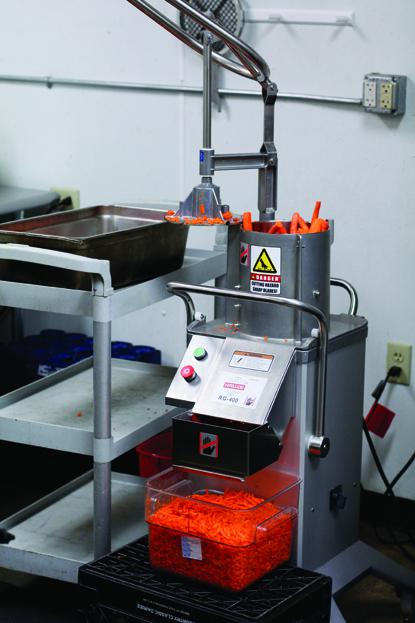Processing Plant Extends the Life of Local Produce

Bozeman is home to the Community Food Co-op. It’s also home to mountains, cows, and hay fields, and for a large part of the year, winter. A long winter means a short season for growing vegetables—not smaller quantities of vegetables, just shorter times when they’re available.
The co-op has been buying locally produced meats and vegetables for its entire 34-year history and is wholly committed to its local suppliers. Co-op management worked with area vegetable growers to take advantage of this short window when so much locally grown produce is available. The result: full-scale processing of vegetables for the co-op’s use—in prepared foods, grab-and-go foods, and more.
Just this past spring, using a grant from the Montana Department of Agriculture’s Growth Through Agriculture, a terrific program that aims to fund small food-production and food-processing projects in the state, the co-op implemented a commercial-scale processing venture for vegetables. Grant monies purchased a food processor, a flash freezer, tables, a walk-in freezer, and more. Grant funds will cover $50,000—about two-thirds of the costs of the equipment—with the co-op covering the difference between the grant and actual costs.
The processing work occurs in the co-op’s central kitchen; deli and to-go foods are prepared there and delivered to two retail stores. As of September 15, the co-op had purchased just under 31,000 pounds of locally grown produce in 2013, of which about 10,000 pounds have been processed in one form or another. (The majority is blanched and frozen, though there is some pickling, fermenting, saucing, and pureeing, as well).
On the whole, Christina Waller, the central kitchen manager, is pleased. Her budgetary goal for produce purchasing is $2.00 per pound, irrespective of source or time of year. In 2013, she is at $2.74 per pound, attributing higher cost to large purchases of more expensive local produce, especially cilantro and basil. “If you took the herbs out, we would be right where we want to be,” Waller says.
Purchasing local produce is more art than science. There are some foods that are cheaper if bought from a large distributor (UNFI or Sysco), but often the local vegetables are significantly less expensive.
A couple of examples: The co-op pays $2.50 a pound for local tomatoes to can for winter use; that compares poorly to the $1.00 a pound for diced tomatoes from Sysco or UNFI.
Canned pumpkins, on the other hand, are a different story. They cost around $1.40 per pound from the big suppliers (plus, says Waller, there are LOTS of very small cans to open), while local pumpkin runs $0.75 per pound. Cost comparisons across the menu suggest that higher prices for one food are largely offset by lower prices for another.
Processing local food also means increases in spending during “local season.” Waller believes the financials will even out over the course of the year (since she will purchase less produce in January), although she concedes that more forward-buying in the summer makes her margins suffer.
She stresses that local purchasing for processing is not an act of charity; this must pencil out if it is to continue, she says. At the same time, she recognizes that the quality difference between local food and big-distributor food is worth increased costs. She is “willing to pay a lot for taste” and believes that sales will increase because co-op shoppers are willing to pay for food “of such higher quality.”
Plus, Waller adds, processing is largely meant to “replace fresh, non-local produce in the winter (not canned items), so an anomaly like the tomatoes hurts us less in the long run.”
She has reason to be optimistic. In 2012, as an experiment with local processing, the Central Kitchen pureed local pumpkins for Thanksgiving pies...and sold more than double the number of pies sold in 2011 (nearly $12,000 in sales, versus roughly $5,000).
To be sure, there are continuing kinks being worked out in this system. Labor costs are one. Processing of local food adds between 40 and 75 hours of labor a week, with three to five part-time cooks doing this work. That labor also fluctuates with the food item—basil and cherries take longer to pick apart or pit than a tomato takes to drop into a food processor.
The increased costs of goods is also indisputable. That impacts the margin, as do the increases in labor—and for a department that does not generate any direct sales. Waller is confident that this will all even out during the winter, but these are challenges that suggest the perspective on budgets, on margins, on costs of goods, and on labor numbers might have to shift to a longer-term view of financial costs in order to see the benefits of local food purchases.
The marketing around local food has increased as well, as a means of helping to drive sales: from social media, to exhibits of photos of suppliers, to blogs and coupons—the marketing efforts at the co-op are increasing proportionately to the increased use of local food. It is not intuitive that the sauce on your pizza in January is from tomatoes harvested right down the road, months before, and the thinking is that members are more likely to purchase local food, even during the winter. The ancillary benefit to this marketing is the increase in loyalty to the co-op among its members, especially in times of increased competition and increased difficulties in brand differentiation.
This effort to process local food is still in its infancy. Although growers, the central kitchen, and the co-op management are all wading into untested waters, Waller says, “we are all proceeding, based a lot on good faith that this will flourish.” Ideally, the support for local food translates directly into support for the local co-op.







